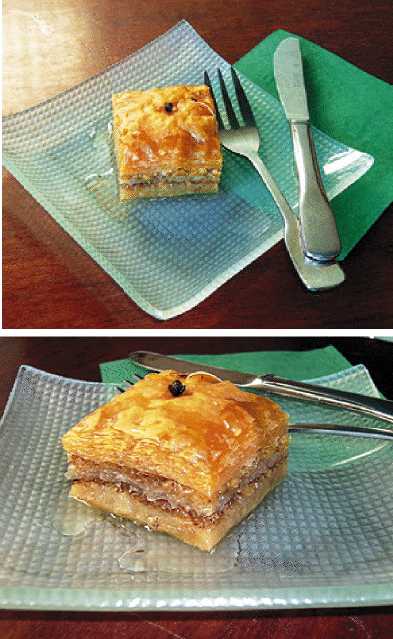 |
||
|
A Sweet Must: Greek Baklava Recipe by Marianthi Milona |
||
|
A DISCUSSION that never ends: Is baklavas, this sweet pastry, Greek or Turkish? Relations between the Greeks and the Turks have by no means always been harmonious--to put it mildly. Even so, there are certain things on which sweet consensus exists, like baklavas for example. And it is not only between these two peoples that this syrup-steeped confection serves as a unifying influence: it is widely known and popular far beyond the Balkans and the East. The Turks called it baklavas and the Greeks took over this name, as many other names, during the Ottoman rule. In the original Turkish version, so-called yufka-leaves, from which burek (pastry pockets) and katmer (puff pastry dainties) were made, formed the basic pastry. The Greeks use fillo pastry which is rolled out as thinly as you could possibly imagine and filled, according to preference, with finely chopped walnuts, pistachio nuts, or almonds. This type of confectionery now occupies a firm place in traditional Greek cuisine, not just as a dessert but as a little nourishing snack to go with a coffee and mater. baklavas is a must whenever you want to spoil your guests, but at the same time it is a popular gift to bring to your hosts.
|
 |
|
|
I wish you a really sweet moment with a piece of baklavas! Baklavas Ingredients ½ cup/50g chopped walnuts or almonds 4 tbsp breadcrumbs 4 tbsp sugar 1 tsp cinnamon 1 cup/250g butter 10 oz/300g fyllo pastry For the syrup: 1 generous cup/250g sugar 7 tbsp/200g honey 2 cloves 1 cinnamon stick juice of 1 lemon Method Mix the walnuts or almonds with the bread-crumbs, sugar, and cinnamon. Melt the butter. Preheat the oven to 350°F (180°C). Grease a shallow baking pan large enough to accommodate the sheets of pastry. Brush the pastry sheets with butter and place the first two into the baking pan. Cover the upper layer with nut filling. Lay another buttered sheet on top and cover with filling. Repeat until you have completed eight layers. Once you have the ninth layer, cut off any excess pastry from around the edge of the baklavas. Place on final buttered layer on top and cut a diamond-shaped pattern into it. Sprinkle with water, bake in the preheated oven for 30-40 minutes until golden brown. To make the syrup, boil the sugar in 6 cups of water for 5 minutes. Add the honey, cloves and cinnamon and continue to simmer. Remove the cloves and cinnamon and stir in the lemon juice. Bring the syrup to a boil, then leave to cool. Remove the confectionery from the oven and pour the syrup over it. For this stage, either the pastry should have cooled and the syrup be warm, or else the pastry should be warm and the syrup cool so that the baklavas do not become too soft. Cut into diamond shapes and serve. Quick tips You can buy ready-made fillo pastry from a Greek or Turkish delicatessen or from supermarkets. (In the United States it can be found as phyllo or fillo pastry in supermarkets.) While you are working, any unused sheets of pastry should be stored between damp tea towels as it dries out very quickly. Making baklavas is a lot of work so it is a good idea to have some help. Sharing the work obviously makes the job easier. While the first pan is ready for the oven and just being brushed with melted butter as a final touch at one end of the table, the second batch is being started at the other end. The nuts are crushed in a mortar. They do not have to be ground evenly. Mix together the nuts, breadcrumbs, cinnamon, and sugar to taste. Brush the first two water-thin sheets of phyllo pastry on the baking pan with melted butter. Make a second layer with 1 buttered sheet and cover with filling, continuing in this way until the 9th/10th layer. Just before baking, cut the characteristic diamond pattern into the top layer of baklavas. Once the pastry has soaked up all the syrup, the baklavas is ready for serving. * Marianthi Milona is the author of the book Culinaria Greece |
||
|
(Posting date 15 February 2008)
All articles of Athens News appearing on HCS have been reprinted with permission. |
||
|
||
|
2000 © Hellenic Communication Service, L.L.C. All Rights Reserved. http://www.HellenicComServe.com |
||

